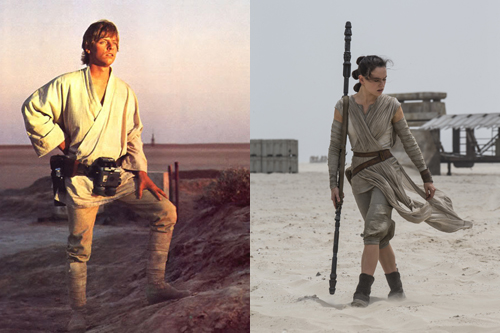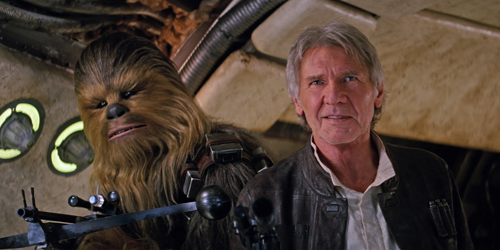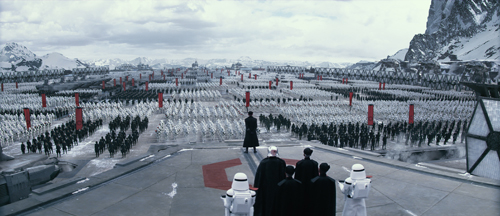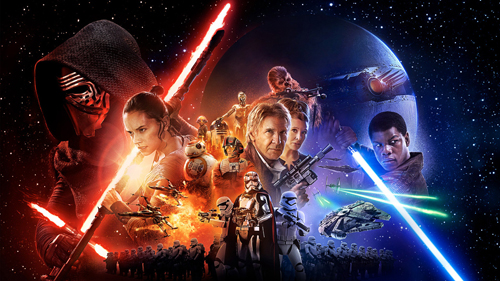
Your complimentary articles
You’ve read one of your four complimentary articles for this month.
You can read four articles free per month. To have complete access to the thousands of philosophy articles on this site, please
Films
Star Wars: The Force Awakens
Jason Eberl and Kevin Decker awaken the philosophy of the Force.
How do you reboot a classic sci fi franchise under new corporate and directorial control while pleasing loyal legions of international fans? You give it to J.J. Abrams, apparently – as his recent big-budget Star Trek and Star Wars films both demonstrate. The six original episodes of the Star Wars franchise are ripe for philosophical, psychological, and religious analysis. But what Abrams brings to the newest installment, Episode VII: The Force Awakens (2015), also demands a meta-philosophical approach.

Dreyja vu: two apparent orphans
Luke Skywalker image © 20th Century Fox 1977
Seeing Double
The internal mythology of Star Wars rests on a kind of dualism, with the dark and light sides of the Force, but Episode VII also deals with a lot of doubles. Critics have pointed out how in The Force Awakens Rey doubles for Luke Skywalker, Finn – as both comic relief and a source of moral ambiguity – doubles for Han Solo, and once again we have a wise, short, and comically odd character in the form of Maz Kanata (cf Yoda). The idea of doubles is a recurrent trope of fiction, which has taken basic problems of reality and appearance from the very start of philosophy. Think for instance of Plato and Aristotle’s use of the idea of mimesis – artistic creation understood as the re-presentation of nature. The ‘doubles’ theme also appears in the ‘double consciousness’ of W.E.B. DuBois, the ‘Other’ in existentialist literature and Lacanian psychoanalysis, and in many other philosophies. As Bryan Seitz of Babson College puts it in his article ‘Philosophy and the Double’, “Philosophy finds power and security in the double but from it simultaneously inherits countless forms of dependence and instability.” The same inheritance of dependence and instability is true of Star Wars. In The Force Awakens, a new masked villain, Kylo Ren, addresses the burnt-out helmet of his grandfather Darth Vader, promising to “finish what you started”; but later, the film’s heroine Rey discovers that Kylo Ren is afraid that he’ll never be as strong as Vader.
The Force Awakens as a whole is itself a double of the original Star Wars film (now known as Episode IV: A New Hope), with some key elements of Episode V: The Empire Strikes Back thrown in. Some complain that Abrams simply retells the original story, with the First Order as ‘Empire 2.0’, and the Starkiller weapon as a bigger Death Star, among other direct parallels. This fact has troubled many fans who left the theater exhilarated as John Williams’ latest score thundered away, only to reach home feeling cheated by the lack of originality in the plot. It’s lmost as if, in order to help the audience overlook the much-derided prequel trilogy (Episodes I-III), Abrams wanted to reassure everyone that “This is your father’s Star Wars.”
Running Circles
In his book Truth and Method (1960), Hans-Georg Gadamer wrote, “The circle of whole and part is not dissolved in perfect understanding, but, on the contrary, is most fully realized.” Correspondingly, each of the Star Wars films needs to be interpreted in terms of the whole story cycle. Our understanding and appreciation of these films is dependent upon what has come before and what we know is coming or anticipate coming later in the saga. (Episode VII does the latter brilliantly in withholding the person of Luke Skywalker for so long.)
In the original film, Darth Vader taunted Obi-Wan Kenobi with the words, “The circle is now complete.” To complete the narrative circle, the heavy emphasis on the doubling of characters, situations, and plot in The Force Awakens will have to be redeemed by Episode VIII, in which our investment in the new characters must be rewarded by taking real risks in a darker, more psychologically-driven plot, as The Empire Strikes Back did in 1980.
Alternatively, it might be said that, on the contrary, Star Wars seems to be trapped within its own narrative structures, endlessly replicating doubles of its original characters and setting them against each other in new concatenations. Perhaps this is done intentionally by the filmmakers, bringing us back to the mythological origins of the film saga by invoking the concept of ‘eternal recurrence’ or the ‘karmic cycle’.

Here comes trouble at the double
Loss & Recovery
If the prequel trilogy was guilty of decadence (both in terms of the moral decay of the Republic and the films’ own overwrought production values), then the newest film must be characterized in terms of loss and recovery. In its final act, classic heroes Han Solo and Chewbacca join with ex-stormtrooper Finn to infiltrate and disable the shields surrounding the evil First Order’s planet-sized Starkiller weapon, which is capable of obliterating entire planetary systems light-years away. Upon discovering that Finn’s job was in sanitation, Han complains that the entire galaxy is counting on them to lower the shields so Resistance forces can fly in and destroy it. Finn responds, “We’ll figure it out, we’ll use the Force!” Han retorts, “That’s not how the Force works!”
Finn’s misunderstanding stems from his having grown up in a society in which the Jedi Order and the Force have been relegated to mythological status. Finn’s world is what Charles Taylor, in his A Secular Age (2007), would call ‘disenchanted’. In a disenchanted world, belief in anything beyond what is evident to the senses or that can be rationally inferred from them has been largely abandoned. Han Solo himself, nearly forty years before, professed his preference for more pragmatic solutions to life’s battles to aspiring Jedi Luke Skywalker, saying: “Hokey religions and ancient weapons are no match for a good blaster at your side, kid… I’ve never seen anything to make me believe there’s one all-powerful Force controlling everything… It’s all a lot of simple tricks and nonsense.” Clearly, everything he has since seen of the Force has satisfied even Han Solo’s demanding epistemic standards.
Re-Enchanting The Galaxy
Abrams and Co. have eschewed the sappy romance, details of galactic economics, and over-reliance on computer-generated characters and settings that led to fan derision of the prequel trilogy. Also apparently abandoned from the prequels is the seeming reduction of the Force from a mystical energy field to ‘midi-chlorians’ – tiny life-forms. Instead, the Force has been returned to its rightful place as something both mysterious and ubiquitous. In the recent film, even non-Jedis, such as the ancient and wise barkeep Maz Kanata, are able to sense the omnipresent Force. Kylo Ren also uses the Force in new ways: not just planting mild telepathic suggestions in the weak-minded, but pillaging his victims’ minds for information.
Combining both views of the Force, one could describe a similar relationship between the Force and the physical world that certain philosophers of mind (such as David Chalmers in The Conscious Mind, 1996) allege to exist between immaterial mental properties – beliefs, desires, propositional knowledge etc – and neural correlates in the brain. That is to say, just because there’s a physical correlate of one’s ability to access the Force doesn’t mean that the Force itself doesn’t remain something immaterial, transcendental. (A physical correlate is arguably necessary to explain how sensitivity to the Force tends to run in families.)
Is the Star Wars galaxy better off for having been re-enchanted in The Force Awakens? One valuable by-product of belief in the Force as a mystical power is that it allows for clear distinctions to be drawn between good and evil. So even though Kylo Ren feels an internal struggle between the light and darkness within himself, he seems to have a clear idea of the difference of the two sides of the Force. The sacrifice he must make to cement his alliance with the dark side, while difficult to go through with, is nevertheless very evident to him.

Looks familiar: Not the first vision of universal order
Heroes & Villains
If a movie writer cares to follow Aristotle’s advice in his Nicomachean Ethics, that cultivating moral virtue from youth is all-important, then a perennial issue for a cinematic saga that aims for universal appeal not only across cultures but also across generations is that a good morality tale must be graspable even by young minds. In this, Star Wars is arguably no different from The Lord of the Rings, The Chronicles of Narnia, or the Harry Potter series. The trade-off for moral simplicity, however, is that there is correspondingly less representation of the complexities of human moral psychology. The story of the fall and redemption of Anakin Skywalker (Darth Vader), as told in the previous six films, does show a degree of complexity, as Anakin seeks to balance his love for his wife and unborn children with his duties as a Jedi Knight. As Augustine would put it in On Free Choice of the Will, Anakin ultimately falls because of his “inordinate desire for temporal goods” or, as the Buddha (and Yoda) would contend, his inability to detach himself from what is perishable and transitory. Complexity is lacking, though, in the repeated refrain of there being a single moment of turning from the light side to the dark, or vice versa: Anakin becomes Vader the moment he attacks Mace Windu in Revenge of the Sith. Then he’s unrepentantly evil for over two decades until the moment he kills the Emperor and is redeemed. Similarly, Kylo Ren struggles with his turn to the dark side until the moment he makes a dire decision which many fans think now makes him irredeemable.
Order & Disorder
The political atmosphere depicted in The Force Awakens thematically mirrors both the galactic politics of the saga’s previous trilogies and the moral motivations of their heroes and villains. ‘The First Order’ is aptly named, since General Hux decries its enemies, the politically dominant New Republic, as “a regime that acquiesces to disorder.” In the prequel trilogy, Chancellor Palpatine fabricated a galactic civil war to destabilize the Old Republic, allowing him to transform a diverse and democratic government into a tyrannical Empire through his manipulation of senators desiring “a safe and secure society.” While the senators’ motivation in trading liberty for security is understandable (even if wrongheaded and shortsighted), Hux’s disdain for the ‘disorder’ of the New Republic appears unmotivated; there seems to be no evident conflict or strife within the new democratic regime other than what the First Order itself introduces.
Perhaps it is worth reflecting here on Abrams’ intentional use of Nazi imagery when Hux addresses his troops before firing the Starkiller weapon. The First Order is not so much combatting the perceived inherent disorder of democratic society, but rather asserting its own ‘will to power’ – to cite Nietzsche’s concept of the fundamental drive of all living beings. Perhaps that same motivation drove Anakin Skywalker towards his destiny as Darth Vader as he strove to control his own fate and that of those he loves – with the classically tragic outcome that he ended up causing the very death he was seeking the power to avoid.

A galaxy of adventure reawakens
All Force Awakens images © Walt Disney Studios 2015
Star Wars Reawakens
As the first in a new trilogy of Star Wars films, The Force Awakens succeeds tremendously in revitalizing the spirit of the original films and functions as an effective foundation for the next two episodes. The strength of Abrams’ direction in extracting dramatic and physical performances, especially from the new leads, makes us genuinely invested in the successes and failures of the next generation of the Resistance in ways that the flat performances of Lucas’s characters in Episodes I-III simply could not. What it fails to accomplish, however – on its own at least – is to move the story forward in a novel direction that introduces new and distinct philosophical questions or issues. As we considered, Star Wars might now be trapped within its own narrative. At the very least, Abrams and his collaborators have once again channeled the persistent appeal of the ‘hero’s journey’ as described by mythologist Joseph Campbell in his The Hero with a Thousand Faces (1949). Whether it’s Anakin Skywalker, Luke Skywalker, or Rey (Skywalker?), we see a young protagonist with a mysterious past living in a desert place, guided by a wise elder, who is led to discover his or her innate potential, and eventually faces a moment of choice between using their power for good or evil. Maybe this oft-repeated cycle also captures the essence of the human condition: a relatively immature species, living in a hostile and unforgiving world whose origin is not fully understood, guided by the wisdom of our philosophical elders as we endeavor to discover our inherent collective potential, continually facing the choice to employ our rationality and autonomy to better or to worsen the world. May the Force be with us all – we’ll need it!
© Profs Jason T. Eberl & Kevin S. Decker 2016
Jason T. Eberl is the Semler Endowed Chair for Medical Ethics and Professor of Philosophy at Marian University, Indianapolis. Kevin S. Decker is Professor of Philosophy at Eastern Washington University. They are the editors of The Ultimate Star Wars and Philosophy (Wiley-Blackwell).








